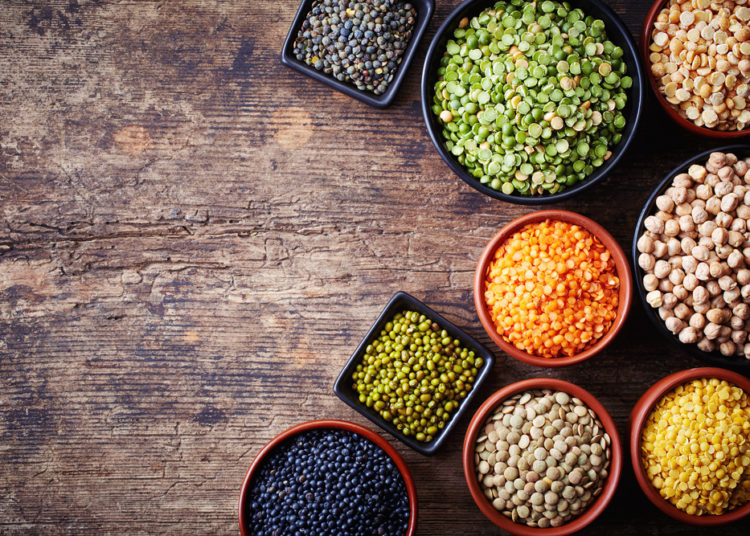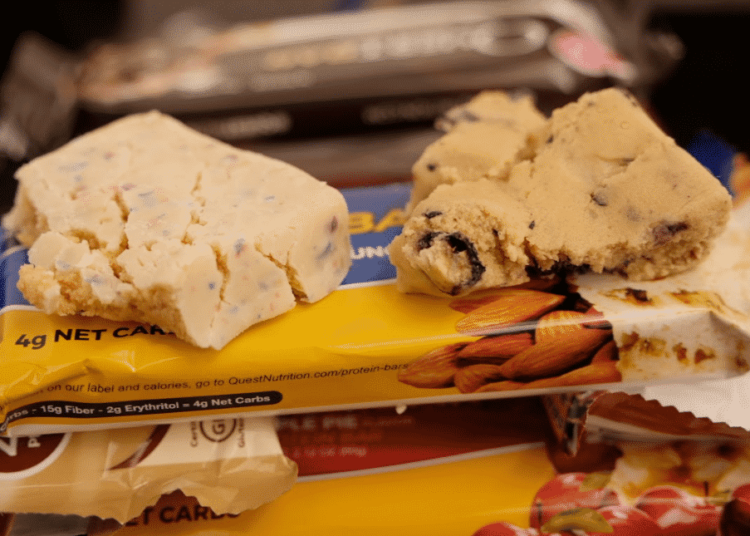Fiber is often recommended as part of a healthy diet for many reasons, from promoting digestive health and blood glucose control to lowering of “bad” LDL cholesterol.
But these aren’t the only reasons why fiber intake is encouraged.
Fiber intake can heavily shape our gut microbiota profile — that’s the trillions of bacteria in your digestive tract that help you to break down food — which may in turn play a key role in controlling stress responses resulting from intense exercise, according to a study in the Journal of the International Society of Sports Nutrition (1).
What’s concerning is that many athletes are advised to follow an eating plan that is higher in simple carbohydrates and protein, and low in fat and fiber — a 2016 study that looked at endurance athletes found they ate less than 25 grams per fiber a day, way below the recommended amount of 38 grams for men and 25 for women. (You’re technically meant to eat 14 grams per 1,000 calories.)
Athletes sometimes forego high fiber foods so that their meals can provide a quick source of energy as well as minimize indigestion and gas. (Low fiber foods are actually a key feature of The Vertical Diet, followed by World’s Strongest Man champions Hafthor Bjornsson and Brian Shaw.)
But insufficient consumption of fiber and resistant starch can negatively affect the gut bacteria and lead to inflammation — and there’s more than one kind of fiber you should consume. Each of the following have their own specific health benefits. (And some foods contain more than one kind.)

Insoluble Fiber
This type of fiber is commonly recognized to help promote laxation (ie. regular bathroom visits) and in preventing and treating constipation. In contrast to soluble fiber, insoluble fiber does not dissolve in water but instead acts by adding bulk to stool, making it easier for waste to pass out of the body. Just think about how vegetables like celery and broccoli stays “tough” and not become mushy when mixed with water- they are high in insoluble fiber consisting of cellulose and lignin, substances that give the strength and “woodiness” to plant cell walls. Insoluble fiber is sometimes referred to as roughage.
Good sources include:
- legumes
- whole grains eg. cereal/wheat bran, brown rice, whole wheat bread,
- many fruits and vegetables like peas, carrots, celery, cucumber and potato (with skin)
[Related: 5 Things Most Athletes Miss About Digestive Health]

Soluble Fiber
On the other hand, soluble fiber is the kind that dissolves in water and thickens up to become viscous and gel-like — for this one, think about how oatmeal is thick and chewy. This effect is considered to be important in producing many of the physiological benefits of fiber including minimizing blood sugar spikes and improving heart health (2). A study concluded that “Fiber needs to gel to keep your patients well”, in recommendation of soluble fiber as a focus for effective fiber therapy (3).
Soluble fiber makes the stomach content more viscous, which has been shown to affect blood glucose and cholesterol concentrations through many ways, including delayed gastric emptying, slower starch digestion and glucose absorption, as well as decreased cholesterol absorption and altered cholesterol production in the liver (4)(5).
Soluble fiber includes pectin, β-glucan, psyllium and gums, and foods such as:
- cereal grains like barley
- oats
- nuts and seeds
- fruits/ vegetables like apples, pears, carrots

Prebiotic Fiber
So far we talked about how fiber can be generally classified based on its solubility in water, and that each of them relate to different physiological effects — but scientists have asserted that another characteristic, ie. fermentability, may matter even more in terms of physiological benefits. Since fiber escapes digestion in the small intestine and arrives in the large intestine intact, it is available for fermentation by the native gut bacteria. In other words, fiber acts as a prebiotic that stimulates the growth and activity of beneficial gut bacteria such as Bifidobacterum and/or Lactobacillus species. These bacteria in turn, produces SCFAs, which have been extensively investigated for their effects on gut health, metabolism, immune and appetite regulation, as well as potential anti-inflammatory and anti-cancer properties (6). Additionally, SCFAs may play a role in improving the absorption of certain minerals like calcium, magnesium, and iron in the colon, as well as modulating bone mass and protection from inflammation-induced bone loss (7).
Generally, fermentable fibers are soluble in water and include fructans (inulin & fructooligosaccharides (FOS)), which belong under the oligosaccharides group. Oligosaccharides can be found naturally in foods or be commercially produced. Inulin and FOS can be found in:
- wheat
- legumes like lentils and chickpeas
- fruits and vegetables like onions, garlic, leek, asparagus, artichokes
[Related: Why Probiotic Bacteria Are Extra Important for Athletes]

Resistant Starch
This may come as a surprise, but resistant starch is considered a type of fiber mainly due to the way it behaves in the gut. While starch typically gets digested and broken down into glucose, resistant starch resists and escapes digestion in the small intestine and is subsequently fermented by bacteria when it reaches the large intestine. Therefore, they also function as prebiotics that stimulate the growth of SCFA-producing beneficial bacteria.
In terms of health effects, resistant starch has been linked to provide benefits in relation to body weight, insulin sensitivity, lipid levels and inflammation, though to date, the reported benefits seemed to be more pronounced in animal models (8). Larger, more well-controlled human studies are still required, but there’s enough evidence that it’s become a popular ingredient in appetite suppressants.
Resistant starch is sometimes added to baked products and beverages to improve texture and health properties (9), but it’s also found naturally in foods like:
- whole grains
- legumes
- cooked and chilled pasta
- potatoes
- rice
- green plantains
Functional Fiber
Note that fiber can be obtained and consumed naturally from fruits, vegetables and whole grains, referred to as dietary fiber; or be found added to food products or in supplements to provide physiological benefits, referred to as functional fiber. A good example of functional fiber is soluble corn fiber, which is added to Quest Bars (and many other protein bars) to keep the net carbohydrate count low.
Not surprisingly, the benefits of consuming dietary fiber trumps that of functional fiber, one of the reasons being that a high fiber diet also increases intakes of other nutrients and bioactive components found in plants like phytochemicals and antioxidants.
Wrapping Up
Remember that most foods contain a combination of different fiber types, so rather than being overly caught up on isolating one type from another, it is probably even more important to focus on getting enough fiber in overall- —something that you probably don’t need to worry about if you generally eat a whole food-based diet that incorporates a wide variety of plants.
References
-
- Clark A, Mach N. Exercise-induced stress behavior, gut-microbiota-brain axis and diet: a systematic review for athletes. J Int Soc Sports Nutr. 2016;13:43. doi: 10.1186/s12970-016-0155-6.
- Fuller S, Beck E, Salman H, Tapsell, L. New horizons for the study of dietary fiber and health: A review. Plant Foods Hum Nutr. 2016; 71(1):1-12.
- Lambeau KV, McRorie JW Jr. Fiber supplements and clinically proven health benefits: How to recognize and recommend an effective fiber therapy. J Am Assoc Nurse Pract. 2017;29:216–223. doi: 10.1002/2327-6924.12447.
- Dikeman CL, Fahey GC., Jr Viscosity as related to dietary fiber: a review. Crit Rev Food Sci Nutr. 2006;46:649–663. doi: 10.1080/10408390500511862.
- Garcia AL, Otto B, Reich SC, et al. Arabinoxylan consumption decreases postprandial serum glucose, serum insulin and plasma total ghrelin response in subjects with impaired glucose tolerance. Eur J Clin Nutr. 2007;61:334–341.
- Capuano E. The behavior of dietary fiber in the gastrointestinal tract determines its physiological effect. Crit Rev Food Sci Nutr. 2017;57(16):3543–3564. doi: 10.1080/10408398.2016.1180501.
- Lucas S, Omata Y, Hofmann J, et al. Short-chain fatty acids regulate systemic bone mass and protect from pathological bone loss. Nat Commun. 2018;9:55. doi: 10.1038/s41467-017-02490-4.
- Snelson M, Jong J, Manolas D, et al. Metabolic effects of resistant starch type 2: A systematic literature review and meta-analysis of randomized controlled trials. Nutrients. 2019;11(8).
- Sharma A, Yadav BS, Ritika. Resistant Starch: Physiological Roles and Food Applications. Food Rev Int. 2008;24(2):193-234.
